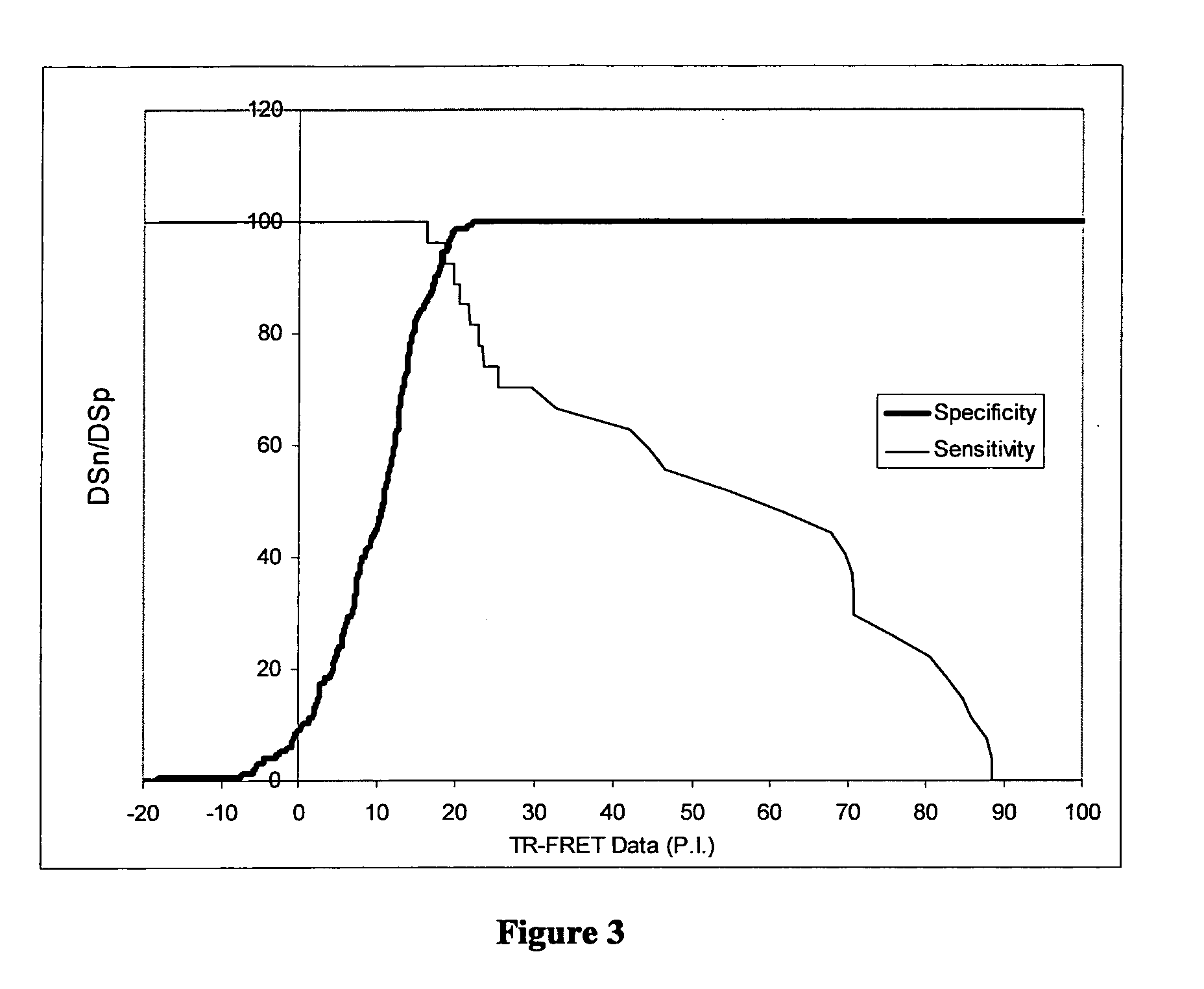Detection method
a detection method and diagnostic moiete technology, applied in the field of detection methods, can solve the problems of insufficient, complicating assays, and far exceeding the fluorescence lifetime of terbium, and achieve the effect of reducing the cost of antigen production techniques
- Summary
- Abstract
- Description
- Claims
- Application Information
AI Technical Summary
Benefits of technology
Problems solved by technology
Method used
Image
Examples
example 1
Diagnosis of Brucellosis
[0087]The applicants developed a TR-FRET protocol as described below. The method was used to analyse samples from Brucella infected and uninfected cattle and the results are illustrated below.
[0088]Antibody Labelling with Terbium
[0089]The BM40 mAb used was a mouse IgG1 antibody specific to Brucella ‘M’ O-antigen epitopes (Greiser-Wilke & Moenning, Ann Inst. Pasteur Microbiol. 1987 138 (5) 549-60). The supernatant from a BM40 producing B-cell hybridoma cell culture was affinity purified using a protein G column.
[0090]To label the antibody, 3 ml of BM40 was dialysed against sodium carbonate buffer (pH 9.5) for 21 hours at 4° C. using a 1-3 ml 10 kDa Molecular Weight Cut-Off (MWCO) Slide-a-lyzer (Pierce™) dialysis cassette. The BM40 mAb was recovered from the cassettes and centrifuged in 3 kDa MWCO Centricons (Millipore, Billerica, Mass.) at 4000 g for 90 minutes at +4° C. which decreased the volume to 0.7 ml. This was spectrometrically determined to be at a con...
example 2
Further Studies Relating to Diagnosis of Brucellosis
[0111]The methods described above in Example 1 were further optimised and validated as described below. The results of further studies using the optimised protocols are also described.
[0112]Test Method
[0113]The labelling of terbium to BM40 was improved by increasing the conjugation time to 6 hrs and removing excess unconjugated terbium by desalting with a 5 ml Zebra™ column (Pierce), as described above, without prior dialysis. This improved the terbium to BM40 molar ratio to more optimal levels. The production yield of Brucella sLPS-FITC was improved by desalting using a PD-10 column (GE Healthcare) following the manufacturers instructions, rather than a Zebra™ column (Pierce). Titration of these reagents against control serum (see above) demonstrated optimal reagent concentrations were 2 nM BM40-Tb and a 1 / 1750 dilution of Brucella sLPS-FITC. The optimal serum sample concentration was determined to be ⅕.
[0114]The TR-FRET assay pla...
example 3
Detection of Diagnostic Moieties for Bovine Viral Diarrhoea (BVD) by TR-FRET
[0139]The applicants developed TR-FRET protocols as described below. The method was used to analyse samples containing anti-BVD antibodies and BVD viral antigens.
[0140]Development of Competitive TR-FRET Method
[0141]The BVD TR-FRET method was developed using the following reagents in a competitive format: biotinylated recombinant BVD E2 antigen, terbium conjugated streptavidin and fluorescein conjugated anti-E2 monoclonal antibody WB214.
[0142]Production of recombinant baculovirus expressing the E2 glycoprotein for BVDV type 1a (strain C24V) was achieved by firstly cloning the region of the bovine viral diarrhoea virus genome delineated by primers BVDV C24V E2 EcoRI and BVDV C24V E2 6His XhoI (Amin Asfor PhD thesis; RVC, University of London, 2006) into the general cloning vector pGEM-T easy (Promega). The primers introduced an EcoRI site, a start codon and a Kozak consensus sequence at the 5′ terminus of the ...
PUM
 Login to View More
Login to View More Abstract
Description
Claims
Application Information
 Login to View More
Login to View More - R&D
- Intellectual Property
- Life Sciences
- Materials
- Tech Scout
- Unparalleled Data Quality
- Higher Quality Content
- 60% Fewer Hallucinations
Browse by: Latest US Patents, China's latest patents, Technical Efficacy Thesaurus, Application Domain, Technology Topic, Popular Technical Reports.
© 2025 PatSnap. All rights reserved.Legal|Privacy policy|Modern Slavery Act Transparency Statement|Sitemap|About US| Contact US: help@patsnap.com



